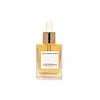What's inside
What's inside
 Key Ingredients
Key Ingredients

No key ingredients
 Benefits
Benefits

 Ingredients Side-by-side
Ingredients Side-by-side

Water
Skin ConditioningGlycerin
HumectantCentella Asiatica Extract
CleansingCalendula Officinalis Flower Extract
MaskingChamomilla Recutita Flower Extract
MaskingTranexamic Acid
AstringentGanoderma Lucidum Extract
Skin ProtectingCynanchum Atratum Extract
Skin ConditioningAlpha-Arbutin
AntioxidantAllantoin
Skin ConditioningPhenoxyethanol
PreservativeBisabolol
MaskingSodium Polyacrylate Starch
AbsorbentSodium Hyaluronate
HumectantBis(Tripeptide-1) Copper Acetate
Skin ConditioningEthylhexylglycerin
Skin ConditioningCeramide EOP
Skin ConditioningCeramide Ns
Skin ConditioningCeramide NP
Skin ConditioningCeramide As
Skin ConditioningCeramide AP
Skin ConditioningHydrogenated Lecithin
EmulsifyingCholesterol
EmollientGlyceryl Stearate
Emollient2,3-Butanediol
HumectantWater, Glycerin, Centella Asiatica Extract, Calendula Officinalis Flower Extract, Chamomilla Recutita Flower Extract, Tranexamic Acid, Ganoderma Lucidum Extract, Cynanchum Atratum Extract, Alpha-Arbutin, Allantoin, Phenoxyethanol, Bisabolol, Sodium Polyacrylate Starch, Sodium Hyaluronate, Bis(Tripeptide-1) Copper Acetate, Ethylhexylglycerin, Ceramide EOP, Ceramide Ns, Ceramide NP, Ceramide As, Ceramide AP, Hydrogenated Lecithin, Cholesterol, Glyceryl Stearate, 2,3-Butanediol
 Reviews
Reviews

Ingredients Explained
These ingredients are found in both products.
Ingredients higher up in an ingredient list are typically present in a larger amount.
Centella Asiatica Extract (Centella) is derived from an herb native to Southeast Asia. It is famous for its anti-inflammatory and soothing properties.
Centella is rich in antioxidants and amino acids, such as Madecassic Acid and Asiaticoside.
Studies show the compounds in centella help with:
The combination of all these properties makes centella effective at soothing, hydrating, and protecting the skin.
Other great components of centella include Vitamin A, vitamin C, several B vitamins, and Asiatic Acid.
Fun fact: Centella has been used as a medicine and in food for many centuries. As a medicine, it is used to treat burns, scratches, and wounds.
Learn more about Centella Asiatica ExtractEthylhexylglycerin (we can't pronounce this either) is commonly used as a preservative and skin softener. It is derived from glyceryl.
You might see Ethylhexylglycerin often paired with other preservatives such as phenoxyethanol. Ethylhexylglycerin has been found to increase the effectiveness of these other preservatives.
Glycerin is already naturally found in your skin. It helps moisturize and protect your skin.
A study from 2016 found glycerin to be more effective as a humectant than AHAs and hyaluronic acid.
As a humectant, it helps the skin stay hydrated by pulling moisture to your skin. The low molecular weight of glycerin allows it to pull moisture into the deeper layers of your skin.
Hydrated skin improves your skin barrier; Your skin barrier helps protect against irritants and bacteria.
Glycerin has also been found to have antimicrobial and antiviral properties. Due to these properties, glycerin is often used in wound and burn treatments.
In cosmetics, glycerin is usually derived from plants such as soybean or palm. However, it can also be sourced from animals, such as tallow or animal fat.
This ingredient is organic, colorless, odorless, and non-toxic.
Glycerin is the name for this ingredient in American English. British English uses Glycerol/Glycerine.
Learn more about GlycerinWater. It's the most common cosmetic ingredient of all. You'll usually see it at the top of ingredient lists, meaning that it makes up the largest part of the product.
So why is it so popular? Water most often acts as a solvent - this means that it helps dissolve other ingredients into the formulation.
You'll also recognize water as that liquid we all need to stay alive. If you see this, drink a glass of water. Stay hydrated!
Learn more about Water